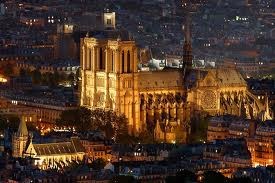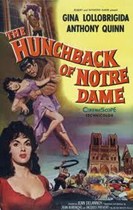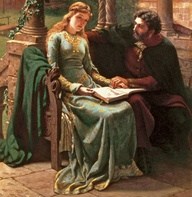V.S.Gopalakrishnan
While visiting Paris, three monuments you should not miss to see are the Eiffel Tower, the Sacre Coeur Basilica [meaning Sacred Heart (of Jesus) Basilica] situated on a hillock and overseeing the city, and the Cathedral of Notre Dame [Our Lady (Mary, mother of Jesus)]. The Cathedral, built over a long period stretching from 1163 to 1345, is right in the middle of the city, adjoining the Seine river, and is an imposing monument in the Gothic architectural style, with two towers rising to 226 feet and a spire rising to 300 feet.

(Notre Dame cathedral by night -photo from Net)
During my two years’ stay in Paris in mid 1970s, I have been to see the awesome Cathedral a few times. I found the door always closed and could never make an entry into it even once for reasons I cannot recollect now but I suppose it was undergoing some sort of renovation work. But I remember I used to sit on one of those benches placed around its expansive front-yard. I used to gaze at the monument and try to absorb its immensity and beauty. The gargoyles and statues were captivating to see. During foreign trips in Europe, I would make it a point to visit cathedrals in order to listen to wonderful organ music played in non-pareil ambience and to marvel at the sights of the lovely tinted glass work and of the statuary. Sadly I could never enter the portals of Notre Dame.
In historic terms, the Notre Dame of Paris has been witness to several significant events. The coronation ceremony of Napoleon and Josephine took place there in 1804. Many other royal crowning and royal weddings too have taken place within its precincts over the centuries. However, there are two fabulous tales concerning Notre Dame which none would not want to know: (1) The story of “The Hunchback of Notre Dame”, a book of fiction written by the great French novelist and writer Victor Hugo (of the “Les Miserables” fame too) and (2) The real life story of teacher-pupil love between Abelard and Heloise.
THE HUNCHBACK OF NOTRE DAME

The most beautiful of the reigning heroines of those days Gina Lollobrigida played the role of the beautiful gypsy girl in the movie of 1956 called “The Hunchback of Notre Dame” in which Anthony Quinn played the role of the hunchback. I have seen this lovely movie a few times for want of reading the book itself! The movie is even available on Youtube in 12 parts.
Victor Hugo was commissioned by his publisher to write a novel relating to Notre Dame Cathedral in a few months but Hugo took nearly two years and the book was out in 1831. Why was Notre Dame chosen for the novel? Well, Hugo was very familiar with the history and architecture of the Cathedral and was always fascinated by it.
A very brief outline of the story of the novel could be given here. In actual fact the central character of the novel is the beautiful young woman “Esmeralda”, a gypsy, rather than the hunchback named “Quasimodo” who worked in the cathedral and whose main job was to ring the huge bell located in the tower. The beautiful and kind Esmeralda captures the hearts of many men including Frollo, the priest in charge of the cathedral; the hunchback and the ugly Quasimodo who worked for Frollo; Captain Phoebus of the King’s Archers and Gringoire, a struggling poet.
Frollo asks Quasimodo to capture Esmeralda for satisfying his own lust. But Captain Phoebus captures Quasimodo during the kidnapping process. As a result Quasimodo is flogged and pilloried in the public place. He was dying of thirst and Esmeralda gives him water and saves his life, reason enough for the hunchback to fall in love with her.
Frollo becomes jealous of Captain Phoebus as he was about to have physical relation with Esmeralda and attempted to kill him. However, Esmeralda got the charge for the attempted murder of Phoebus and she was to be publicly hanged. Before the hanging, Quasimodo abducts her and takes her into the cathedral where she could not be acted upon under the “law of sanctuary”. The King however removes her immunity. And there is tragedy in different ways to Frollo, Quasimodo and Esmeralda which need not be detailed here.
No reading of the book can give you the impression that you would get by seeing the movie. The actions inside of the cathedral as well as the insides of the cathedral that are shown are fascinating with the high stairs, the huge bell, the statues, the tinted glasses etc. I wonder whether they created a set in the Pinewood studios (UK) or at Hollywood. Esmeralda and Quasimodo are top indelible names from world literature.
WORLD FAMOUS LOVE AFFAIR BETWEEN ABELARD AND HELOISE
The teacher Abelard and the student Heloise were real life passionate French lovers as famous as Romeo and Juliet of the English fictitious play. They lived in the 12th Century France. Notre Dame cathedral did not exist then and yet there is a reason why I brought in this story here which I shall explain in due course.
Peter Abelard (1079-1142) earned great fame even early in life as a remarkable teacher, a significant philosopher and a fine theologian. Students from all over Europe came to Paris to hear his lectures. Abelard on a couple of occasions eclipsed his own master, William of Champeaux, in philosophical disputations. Notre Dame was a church before the cathedral came in there, and Abelard even obtained a post in the church.
Heloise (1101-1161) was a beautiful young lady who came to stay with uncle Fulbert, a Canon of Notre Dame church, Paris. She was 22 years younger to Abelard and was a student with extraordinary merit. And Abelard became her personal teacher and not only that, he stayed in her uncle’s house. Abelard and his student Heloise fell in deep and passionate love. Abelard even wrote about how he managed to seduce her and in due course her uncle Fulbert managed to find out that the two were in illicit relationship. Fulbert separated the two and yet they met in secrecy.
Heloise became pregnant and she was sent away to Brittany (in France) where she gave birth to a son. Different kinds of stories exist with regard to whether and how Abelard married Heloise. And different versions of story relating to how Abelard was attacked and was castrated also exist. Abelard became a monk, and far away Heloise became a nun. They wrote letters to each other for nearly twenty years touching on love, philosophy, theology etc. The letters have been published for the benefit of the public. Abelard also wrote a kind of autobiography titled “Historia Calamitatum”, talking about his calamities as a philosopher before becoming a monk and his calamities after he became a monk. Several of Abelard’s theological propositions and interpretations were attacked by several monks who became his enemies.
Today, the common tomb of both Abelard and Heloise is to be found in the well-known Paris cemetery called Pere- Lachaise. Yet there again there is a controversy about whether their real remains were interred there. Abelard and Heloise were two extraordinarily gifted and brilliant persons and it was the sign of the times that their passionate love was disapproved and their lives converted into tragedies.

(Abelard and Heloise - in a painting - from the Net)
======================================

No comments:
Post a Comment